[CheetahSoft, ZX Spectrum]

The British gaming scene has been praised for a lot of things, but no one mentioned this edge: when I am stuck between professional commitments and long games, I can always pick a Spectrum or BBC Micro game and review it quickly. That’s why I picked Conquest, but well, unfortunately for my writing schedule, there was more than met the eye.
Conquest is the quintessential wargame: the objective is to paint the map my colour (red), starting with the location of my choice – I pick a non-descript square somewhere on the Western coast of Italy for no reason at all.

I start with one Legion (the one of the Emperor) and with it I immediately start painting the map. Conquest of barbarian (=green) territories is automatic: you just need to move into it. On the other hand, barbarians can randomly recapture any undefended territory bordering horizontally or vertically another barbarian territory, as happens below:

The Adriatic Sea provides no shelter, as in-game any land pixel makes a territory reachable from all four directions; in game terms there is no Adriatic Sea at all!

The Barbarians are more aggressive over time, and I have a growing number of undefended territories. Happily enough, I can deploy up to 10 forts that the Barbarians cannot ever pass, and for every 5 territories (called “taxes”) I receive an additional legion, which can conquer more territories and of course protect them.
By turn 17, I had 3 additional legions, and was deploying a line of forts on the Adriatic Sea:
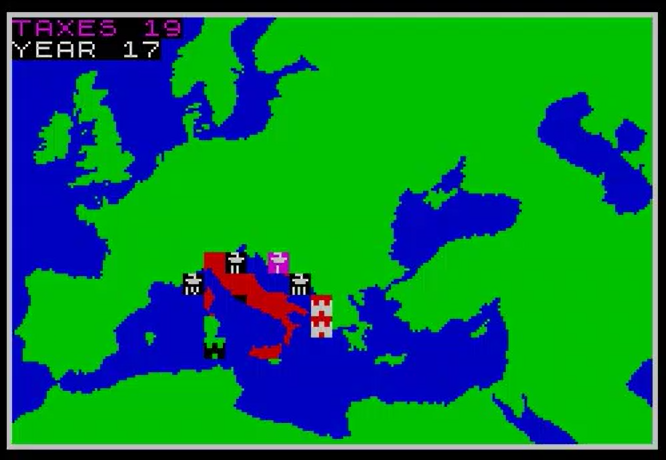
I continue painting my corner of the map red, deploying forts to cover my Eastern flank and advancing in a way that leaves no opening to the Barbarians. My Emperor dies, but he is replaced without any succession crisis by the general who controlled the most experienced legion – that is to say the one that has conquered the most territories.
By turn 28 I have a good number of regular legions (in black), but they all start in Rome and then move by one square by turn, so it takes some time before they reach the frontline. On the other hand, the Emperor’s legion (in pink) can move for free in controlled territory – not that I need that a lot at the moment:
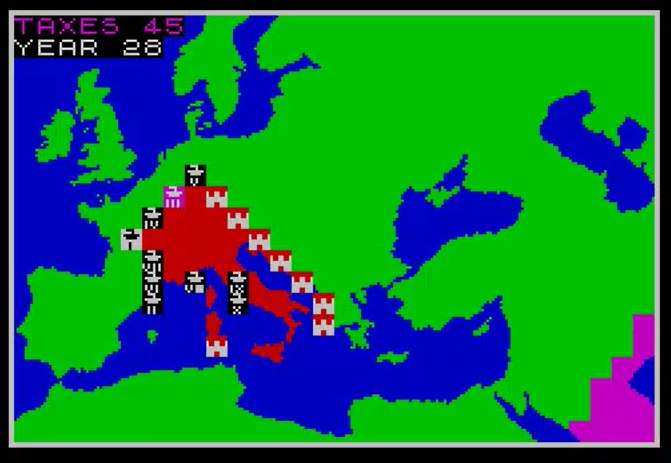
My systematic approach works well, until this happens:

This time, the death of the Emperor immediately triggers a civil war. Some legions support the challenger and become green on the map. They don’t move and they still stop barbarians, but I can’t control them. By coincidence, all the rebels were legions either in transit or defending the Hispania border:
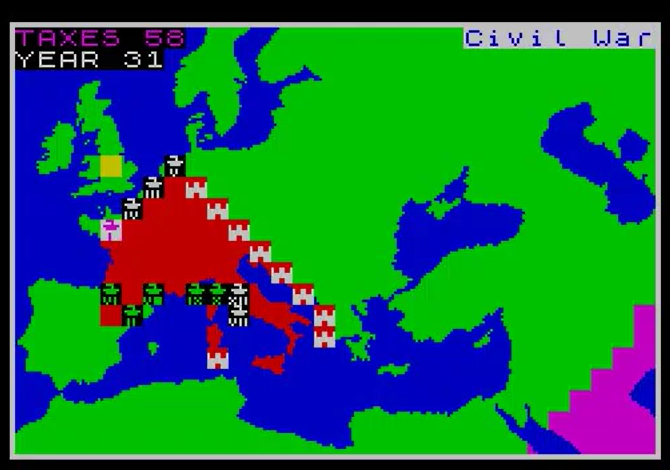
The game keeps a “combat record” of all legions (it can be reset for individual legions if their “general” randomly dies in combat). To defeat a rebel legion, I need to fight it with a legion with equal or better combat experience. If on the other hand I send a weaker legion, it will be defeated and reconstituted in Rome.

I leave a gap in my frontline to send the Emperor personally bash some skulls. Once the rebels are pacified, I resume the offensive, reach the middle of England, and lose my Emperor again:
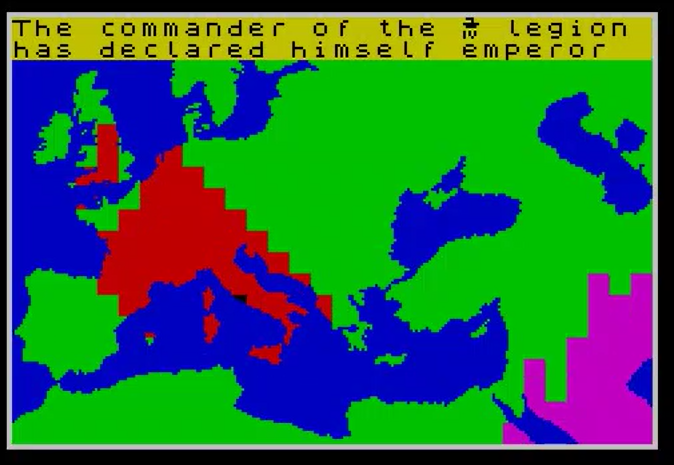
Unlike last time, I can’t crush the rebellion while keeping my frontline airtight – I just don’t have the time. A new rival appeared in Numidia and expands quickly. As long as I am in a civil war, neither the rebel legions nor the forts protect me against rival empires – that’s why the latter are incredibly more dangerous than mere barbarians. I need to quell the rebellion quickly before the Numidians attack through Sardinia.
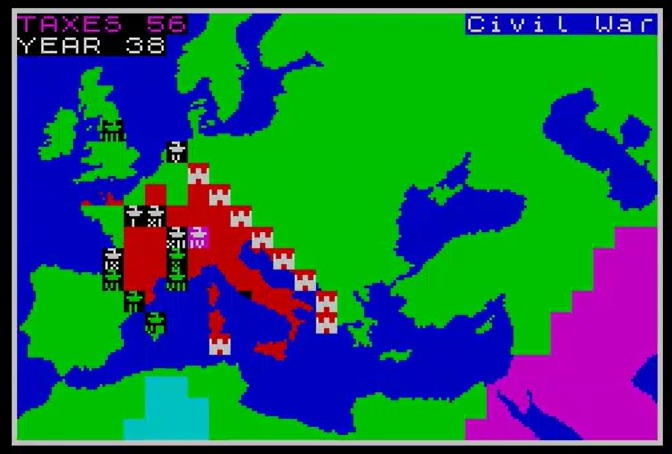
It took me a long time to regain control, and ultimately I had to defend Sardinia with loyal legions. By the time I can resume the conquest of England, the Numidians are in Spain.
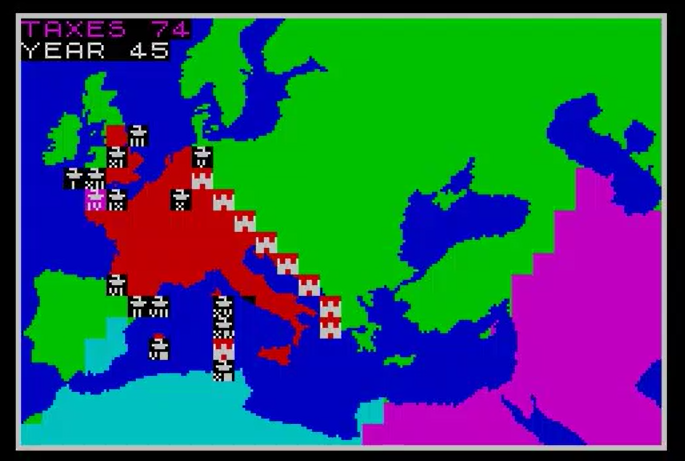
While finishing off Spain, I launch an attack on Tunisia with all the legions I have available. The game ends turn 51 as I take control of my 100th square:

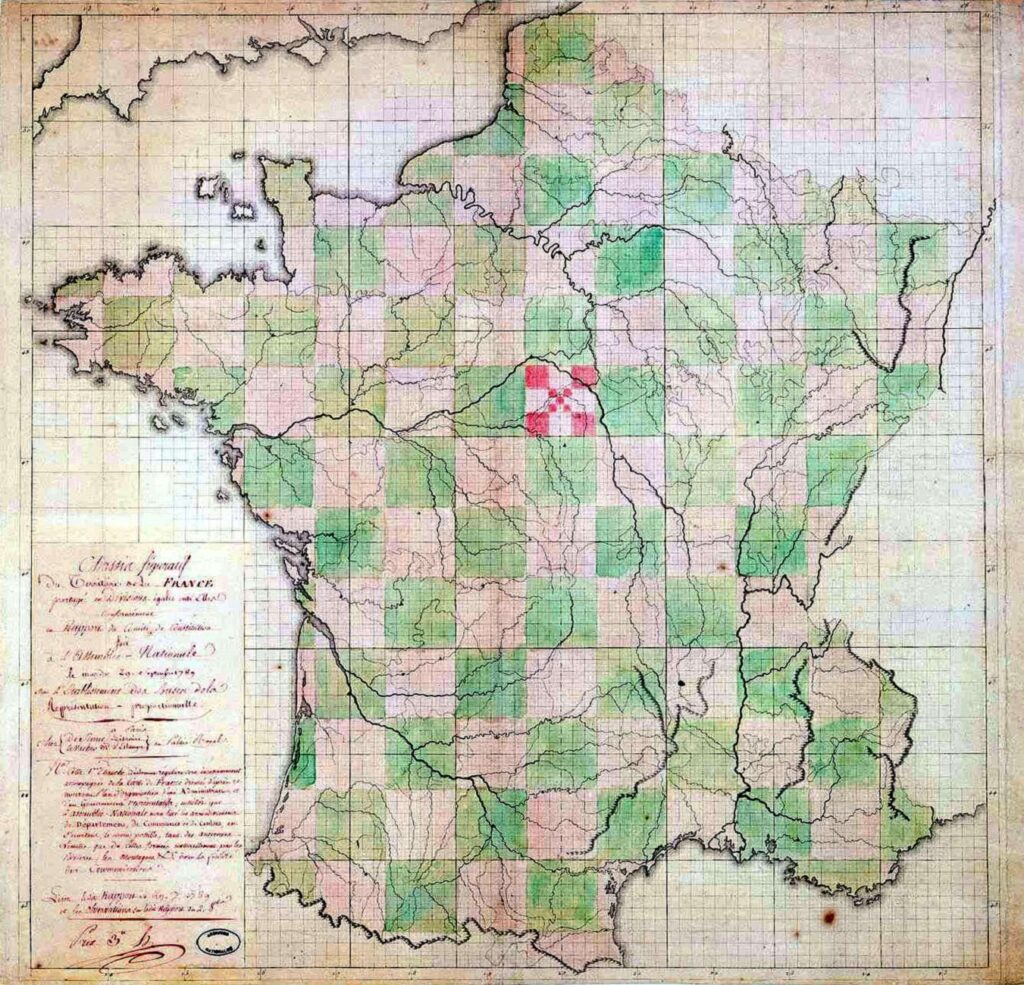
The game gives me a score: Not bad!

This may look like an easy victory, but this was my 5th “serious” attempt. I usually only showcase one serious attempt, whether I win or lose it, but my pride was hurt to have been unable to beat a deceptively simple-looking Spectrum game. There is no leeway for mistakes – or bad luck – in Conquest, as the barbarians can immediately punish you and dig several squares into your Empire in one turn, losing precious time. As for the rival Empires, they can destroy you in a few turns if you have a civil war at the wrong moment!
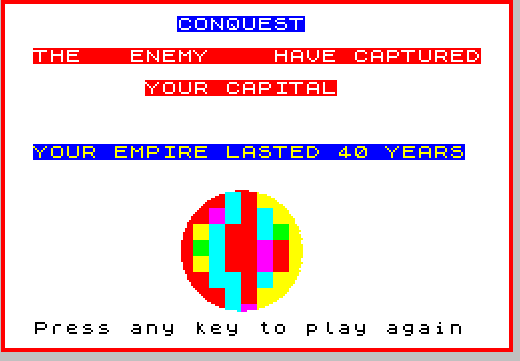
On his site, author Duncan Nightingale shows he finished the game in 37 turns, so I still have a long way to go.
After victory, you can continue the game and conquer the whole map with a new “advanced” ruleset, which includes the ability to build ports to teleport your legions from one region to another. I did not fancy myself the red Pierre Soulages, but still carried on a few turns, just enough to showcase the devastating effects of a plague:
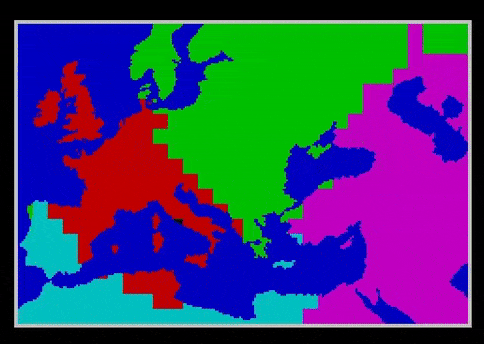
I could never get the ports to work, and after some more turns a Civil War allowed the Mesopotamian Empire to breach my wall of forts. This was a situation I could not recover from: to end a Civil War you need to beat all your rebel legions, and some of them were deep in enemy territory. The “Advanced Ruleset” looks more like a bonus than the core of the game (Nightingale did not show it at all on his website), so I called it a day and resigned, or whatever it is that happens when the Emperor retires to spend his remaining days oyster farming instead.
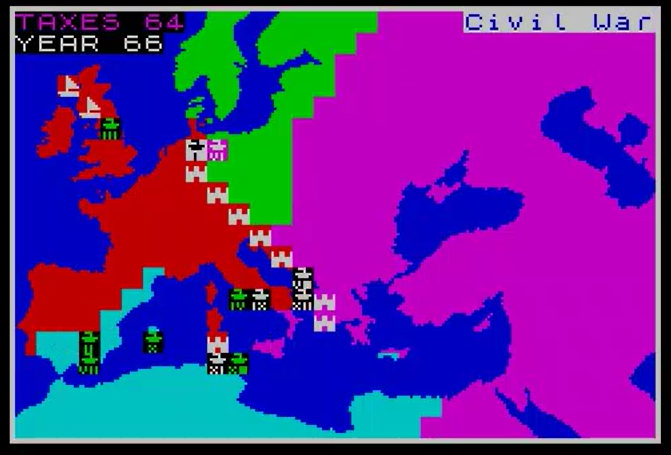
Ratings and Reviews

Conquest by Duncan Nightingale, published by CheetahSoft, UK
First release: May 1984 on ZX Spectrum
Genre: Conquest ^^
Average duration of a campaign : 45 minutes
Total time played : 4 hours
Complexity: Easy (1/5)
Final Rating: One Star
Ranking at the time of review: 36/130
Conquest is Duncan Nightingale’s only known published game. On his personal page, Nightingale recounts acquiring his Spectrum in his final year at University. He wrote several games, but he describes Conquest (“loosely based on the board game Risk“) as the most successful after he sold it to CheetahSoft – it is unclear whether it was a lump sum of money or royalty-based. In any case, Nightingale explains that “the amount of money I was paid covered all the tuition fees for my Masters degree (with some to spare)” so if it was royalty-based then the game sold well. Unfortunately, that’s the extent of the information that Nightingale gives and he did not answer yet to my email.
As for CheetahSoft (slogan: “Soft, we’re not“; for the record they’re not cheetahs either), it is a branch or a brand of Cheetah Marketing Ltd, a company whose first digital footprints can be found in 1983. Despite its name, Cheetah Marketing was selling hardware, specifically RAMpacks and the Cheetah Sweet Talker, which “[made] your SPECTRUM and ZX81 Talk!“. CheetahSoft itself appeared early 1984, with the first ads in May 1984 showcasing two games: Conquest and 3D Bat Attack (largely a first-person Pac-Man). It released a few more games later in 1984 and in early 1985: the well-received Moonsweeper (a shoot’em up with cool transitions between space and atmospheric gameplay), two pointless arcade games: Dragonfire and Perils of Bear George (the “Perils” being “dastardly squirrels, skiers and spiders“) and finally the platformer Parky and the Yellow Submarine for Commodore 64. This activity must not have met expectations, because no further games were released. From what I understand, all these games were coded by external developers.
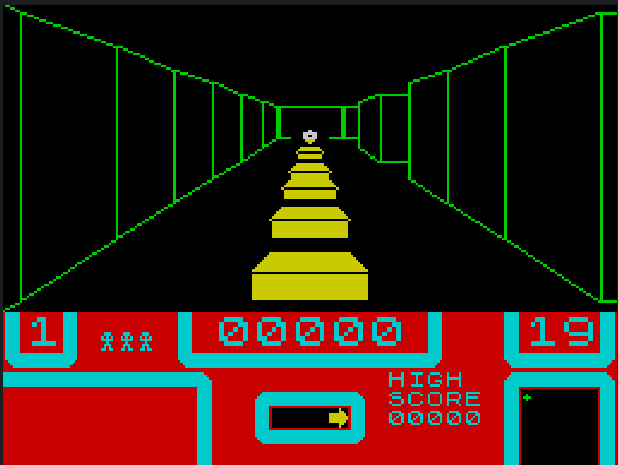
CheetahSoft was shortlived, but Cheetah Marketing thrived for a few more years, quickly specializing in two lines of items: joysticks and music products, both software and hardware (eg the SpecDrum). It would even release a few more simple games, but only to give owners of its critically acclaimed Defender Light Gun something to shoot at. According to Wikipedia, Cheetah Marketing ultimately closed in 1993.

A. Presentation: Adequate. There is nothing fancy, but transitions and menus are polished. Nothing either adds to or detracts from the experience here.
B. UI, Clarity of rules and outcomes: Very poor. The game combines the absolute best for 1984 with some hard misses, so this was hard to rate, but at the end of the day this is a category where it is better to be adequate in everything rather than great at only one thing and lacklustre in others.
On the “absolute best” side, the game comes with 6 levels of difficulty that gradually add new rules, making the onboarding uniquely smooth. I think it might be too gradual: the difference between levels 2 and 3 is that in level 3 the Emperor can be randomly assassinated instead of just dying in combat.
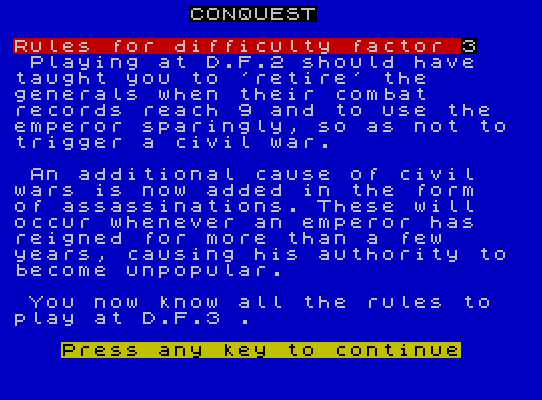
On the negative side, two issues:
- The game is slow. Barbarian attacks and plagues take ages to resolve and while in modern times one can accelerate the emulator, if you pass the threshold where those resolutions are not too long you also pass the threshold beyond which the game is unplayable when it’s your turn.
- Your own units are hidden from you, except at the beginning of the turn. For a game so dependent on perfect unit placement, that’s almost a showstopper:
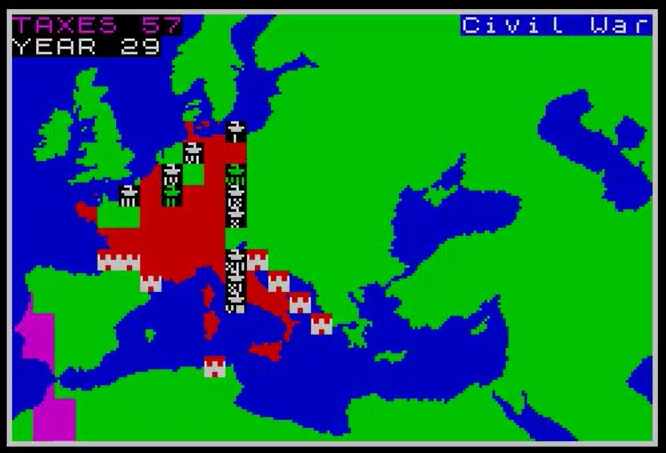
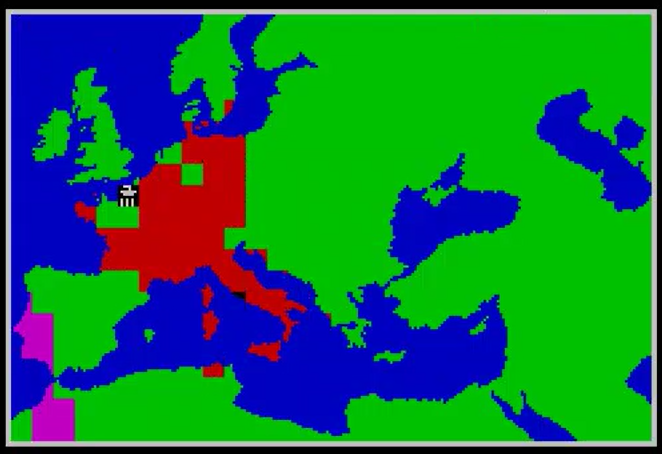
C. Systems: Quite good. This is the best ruleset for the subgenre I call, well, “Conquest” (“strategy game where the player controls all the military of a country/planet. War is streamlined with only 1 or maximum 2 types of units, economy is automatic, new territories usually immediately generate new units“). I find this sub-genre generally stale: few decisions to take, and the game quickly snowballs, with whoever took the lead early able to easily consolidate it until victory.
Conquest avoids this pitfall by making the barbarians more aggressive over time and by having its Civil War mechanics. Early game, civil wars force you to arbitrage between crushing the rebellion quickly by having all your legions track rebels – at the risk of letting the barbs’ pour in – or crush them slowly, but let your rivals grow meanwhile. Later in the game, civil wars become dangerous, as now your rivals can overrun your carefully laid out defences. This is a smart solution to the problem of snowballing and it kept me on edge until the end.
But just like the user interface, the ruleset has important weaknesses that prevent me from ranking it highly in this category. In addition to the frustration of having rebel legions stuck deep into enemy lines, I reckon the game is a bit too random for my taste (plagues in particular can immediately ruin your game if they happen in the wrong location at the wrong moment). It is also too simplistic: there is no development options (where is my Via Appia?), rebel armies are static and rival empires are nothing more than barbarians on steroids (they don’t have armies or forts, they just have a high growth rate and the capacity to go through your defence during civil wars).

I suppose that Nightingale wanted to keep his game simple, but he had this cool tutorial tool to gradually increase complexity that he could have used for real jumps in complexity.
D. Scenario design & balancing: Poor. Despite the 6 levels of difficulty and the choice in initial placement, I feel the game is too random and the geography unsatisfactory.
For the curious, the 6 levels of difficulty are:
- Level 1: Just you and the barbarians. No civil war, no rival empires,
- Level 2: Civil Wars can happen if the Emperor dies in battle (10% chance) or if another commander reaches 10 victories,
- Level 3: Same as level 2, but the Emperor can be randomly murdered even if not fighting,
- Level 4: Same as level 3, but there are up to 3 rival Empires and the player can build forts,
- Level 5: Same as level 4, but there are also random plagues,
- Advanced: Only triggered after finishing a level 5 game. The player can build ports and up to 50 forts, but they have a maintenance cost.
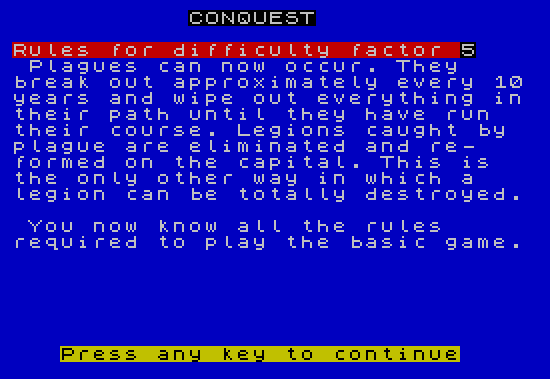
E. Did I make interesting decisions? Yes. Alas, most decisions are tactical (Should I use the Emperor to take that extra tile at the risk of losing him? Should I reassign this legion getting a little too veteran to garrison duty? Should I tell those tiles first?) because once you started expanding in one direction you cannot pivot as you cannot redeploy your forts.
F. Final rating: One star. Conquest is a good surprise, but unfortunately it is badly hurt by an UX issue that should have been tractable even in 1984. It is still slightly better than Nebula, the other Conquest game that I somewhat liked.
Reception
Conquest received the whole Spectrum reviews. Starting with the best one, Home Computing Weekly gave the game 4 stars, describing the game as “very well thought out and easy to grasp in spite of its complexity. An excellent introduction to wargaming for the novice and well worth buying for the expert.” – this generally mirrors my view. Personal Computer Games‘s review of the game (August 1984)is very close in tone, but they give only 6/10 to the game, possibly due to sound and graphics. Sinclair User (July 1984) gives the same grade, but justifies it – fairly I believe – by the “painfully long-winded” turn resolutions.
And then there’s Crash which reviewed the game twice (September and November 1984). Both are the kind of reviews where the reviewers disliked the game so much they felt entitled to a mean joke every other line: “The best part of the game is the map of Europe, which is very well drawn” “After reading through 48K of instructions I felt I needed a rest“, “Summary: Go forth and watch TV“. Maddingly, one of the reviewers complains that after hacking the game to jump from level 1 (a tutorial) to level 5 (” leaving my original conquests“), the game was still boring. I read that as pretty unprofessional: imagine giving you infinite resources in a RTS, building a full base, removing the infinite resource cheat and then calling the game boring because with your base you can roll over everyone – that’s how it reads.
Next update, I will finally conclude on War in Russia, as I finished the 1942 campaign. Does Russia speak German? Answer later this week.